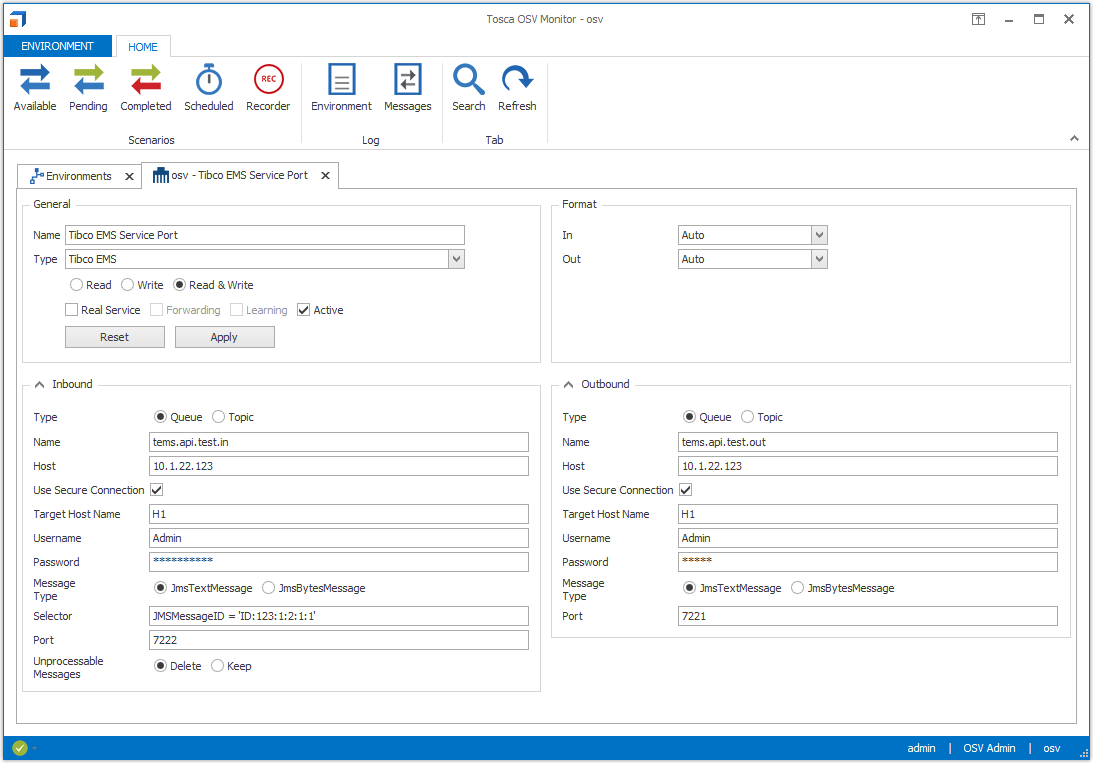Configure Tibco EMS
Use the service port type Tibco EMS to connect to Tibco EMS queues or topics and to push and pull messages.
For information on Tibco EMS, see the Tibco EMS documentation.
Prerequisites
To use Tibco EMS, you have to install the Tibco EMS Client Library.
Configure your service port
Once you have created your service port, you can configure the general service port details:
|
Attribute |
Description |
|---|---|
|
General - Name |
Enter the name of the service port. |
|
General - Type |
Select your service port technology. |
|
Read / Write / Read & Write |
Select what your service port should do with messages:
|
|
Real Service |
Select if you want to connect to a real service. |
|
Allow OSV to forward requests to the real service. To use this option, you need to select Real Service. |
|
|
Allow OSV to store forwarded messages in the Recorder tab. To use this option, you need to enable Forwarding. |
|
|
Active |
Select if you want your service port to be active, deselect to set it to inactive. |
To connect to Tibco EMS, specify the following attributes:
|
Attribute |
Description |
|---|---|
|
Type |
Select Queue or Topic. What you select depends on how you push and pull your messages with Tibco EMS. Queues represent a one-to-one messaging pattern, topics allow one-to-many messaging. |
|
Name |
Enter the name of the queue or topic you want to connect to. |
|
Host |
Enter the name or IP address of the host. |
|
Use Secure Connection |
Select this option to use Secure Sockets Layer (SSL) protocol. |
|
Target Host Name |
If you enabled Use Secure Connection, specify the server certificate name. The ROOT-CA-certificate for this certificate must be available in the trusted store. |
|
Username |
If your connection requires authentication, enter your user name. |
|
Password |
If your connection requires authentication, enter your password. |
|
MessageType |
Specify what type of message you want to send and receive: JmsTextMessage or JmsBytesMessage. |
|
Selector |
Define a selector to filter the headers and properties of incoming JMS messages. This enables you to receive only JMS messages that match your filter criteria. For detailed information on the predefined selectors for this technology, see the Tibco EMS documentation. |
|
Port |
Specify the port to access the broker. |
|
UnprocessableMessages |
Define how to handle messages in a queue that a client can no longer process:
This applies only to queues, not to topics. |

Tibco EMS service port
To save your changes, click Apply. To discard your changes, click Reset.
Once you have configured your service port, you can use your Tibco EMS connection for testing. For information on how to edit JMS messages for your OSV Scenarios, see chapter "Edit JMS messages".
Work with temporary queues
In Tibco EMS you can work with temporary queues that are created during run-time. This applies for outbound queues and real service outbound queues. For detailed information on temporary queues, see the Tibco EMS documentation.
To work with temporary queues in OSV, follow the steps below:
-
Go to the Outbound section of the Tibco EMS service port. To see this section, you need to set your service port to Write or Read & Write.
-
Leave the Name field empty. In this case, OSV assumes that you use a temporary queue and sends responses to the destination specified in the ReplyTo field of the actual request message.
-
In Tosca Commander, configure your OSV Scenario to ensure that OSV matches the correct response to the correct request.
This means that the MessageID of the request message has to be the same as the CorrelationID of the response message. You have to set the following ActionModes:
-
In the request message, set the MessageID ActionMode to Buffer.
-
In the response message, set the CorrelationID ActionMode to Insert.
-